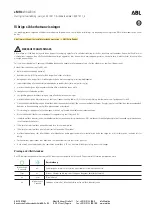
Your vehicle may or may not have roof-rail airbags. See
Airbag System on page 2
‑
66
. Roof-rail airbags are
intended to inflate in moderate to severe side crashes.
Roof-rail airbags will inflate if the crash severity is
above the system's designed threshold level. The
threshold level can vary with specific vehicle design.
Roof-rail airbags are not intended to inflate in frontal
impacts, near-frontal impacts, rollovers, or rear impacts.
Both roof-rail airbags will deploy when either side of the
vehicle is struck.
In any particular crash, no one can say whether an
airbag should have inflated simply because of the
damage to a vehicle or because of what the repair costs
were. For frontal airbags, inflation is determined by what
the vehicle hits, the angle of the impact, and how
quickly the vehicle slows down. For roof-rail airbags,
deployment is determined by the location and severity
of the side impact.
What Makes an Airbag Inflate?
In a deployment event, the sensing system sends an
electrical signal triggering a release of gas from the
inflator. Gas from the inflator fills the airbag causing the
bag to break out of the cover and deploy. The inflator,
the airbag, and related hardware are all part of the
airbag module.
Frontal airbag modules are located inside the steering
wheel and instrument panel. For vehicles with roof-rail
airbags, there are airbag modules in the ceiling of the
vehicle, near the side windows that have occupant
seating positions.
How Does an Airbag Restrain?
In moderate to severe frontal or near frontal collisions,
even belted occupants can contact the steering wheel
or the instrument panel. In moderate to severe side
collisions, even belted occupants can contact the inside
of the vehicle.
Airbags supplement the protection provided by safety
belts. Frontal airbags distribute the force of the impact
more evenly over the occupant's upper body, stopping
the occupant more gradually. Roof-rail airbags distribute
the force of the impact more evenly over the occupant's
upper body.
But airbags would not help in many types of collisions,
primarily because the occupant's motion is not toward
those airbags. See
When Should an Airbag Inflate? on
page 2
‑
70
for more information.
Airbags should never be regarded as anything more
than a supplement to safety belts.
2-71
Содержание 2010 Colorado
Страница 6: ...2 NOTES vi ...
Страница 8: ...Instrument Panel Manual Transmission shown Automatic Transmission similar 1 2 ...
Страница 30: ...2 NOTES 1 24 ...
Страница 46: ...Put someone on it Get it up to speed Then stop the vehicle The rider does not stop 2 16 ...
Страница 114: ...2 NOTES 2 84 ...
Страница 179: ...United States automatic transmission 2 9L version shown Canada manual transmission 3 7L and 5 3L similar 4 19 ...
Страница 222: ...2 NOTES 4 62 ...
Страница 294: ...When you open the hood on the 5 3L engine you will see the following 6 14 ...
Страница 394: ...6 114 ...
Страница 413: ...Engine Drive Belt Routing 2 9L and 3 7L Engines 5 3L Engine 7 13 ...
Страница 415: ...Maintenance Record cont d Date Odometer Reading Serviced By Services Performed 7 15 ...
Страница 416: ...Maintenance Record cont d Date Odometer Reading Serviced By Services Performed 7 16 ...
















































